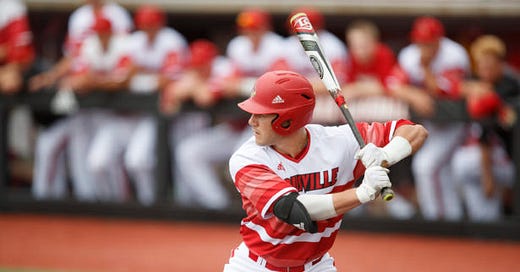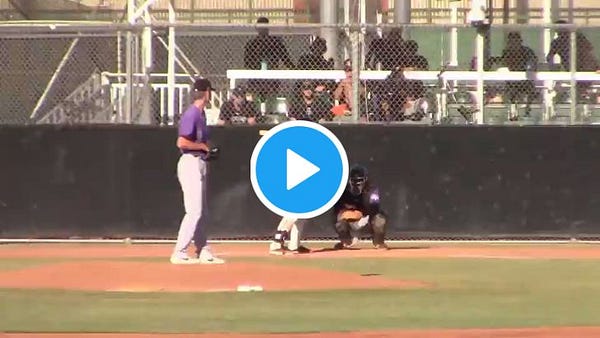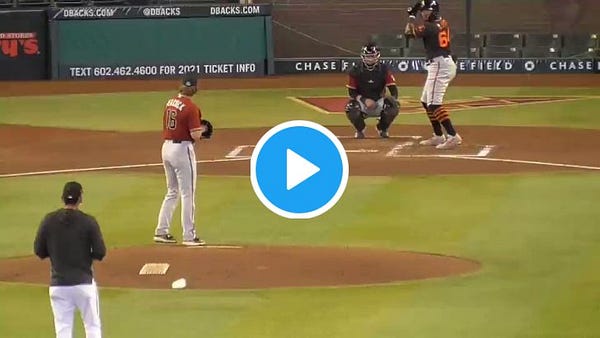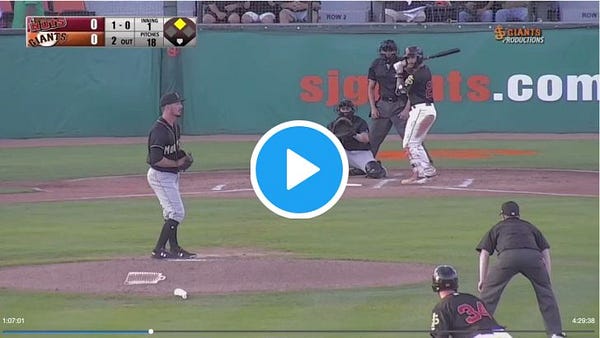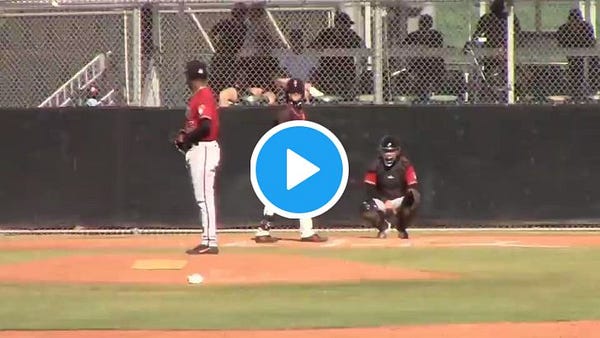Which Type of Hitters Will Giants Develop Best?
Let's look at a couple of archetypes in the Giants' system
Photo Credit: Jeff Reinking | Louisville Athletics
Good morning and welcome to a new week of baseball! Full squads are reporting, beat reporters are descending on Scottsdale, and games will soon commence. Little darling, it seems like years since it’s been here!
Let’s start the week off with a little trivia question, shall we? In honor of Farhan Zaidi spending “way too many hours” staring at Tommy La Stella’s ratio of walks (27) to strikeouts (12) last year, let’s think about this: in 2019 the Giants had five minor league players who posted more walks than strikeouts. One of those was Breyvic Valera, whose short stay in the organization produced 16 walks and 10 Ks. But who were the other four?
While you’re thinking about that, I want to return to a topic I touched on last week with regards to 1b Logan Wyatt, a somewhat surprising invite to spring training.
Let me just snip out a bit from last week’s post to introduce this:
<snip>
Last week, Fangraphs’ Eric Longenhagen hosted a fascinating “Film Room” discussion with Kevin Goldstein, the one-time lead prospect writer for Baseball Prospectus, who later became the Director of Pro Scouting and Special Assistant to the GM for the Houston Astros before getting caught up in their cheating scandal and returning to the writing world. I’m going to return to this “Film Room” session, which focussed extensively on Giants prospects, in a later post, and I’d recommend you watch the entire thing. But, for now, I’d like to focus on KG’s comments on Wyatt, which you can hear in this clip:
KG’s audio is a little hard to hear, so let me give you the salient bits. Longenhagen starts out saying he thinks he might have been a little low on Wyatt in the draft and KG interrupts him with a mirthful “I don’t think you were?” Goldstein then launches on this soliloquy:
I definitely have some experience with this guy. This guy really looks like he can hit. It’s a really good approach, an outstanding understanding of the strike zone, outstanding plate discipline, really good approach and understanding of the strike zone itself. He knows what to swing at, knows what he can get ahold of, works the count exceptionally well. And yet, I just…..I don’t know, these guys drive me crazy. This is another XXL frame, a large human being and he’s a 1b. He’s got an approach. He can get bat on ball. He just doesn’t hit balls that hard. It’s just not who he is.
As Goldstein finishes up this near-rant, Wyatt draws a walk and Longenhagen notes that the penultimate take was exceptional and Goldstein agrees with “that’s what he does.”
<snip>
Meanwhile, there was another moment during the talk that went almost entirely uncommented upon — Armani Smith lacing a double into the gap:
And those two moments in juxtaposition to each other prompted me to wonder — which of these guys are the Giants going to be able to develop most successfully. And from the specific to the generic, from individual to type, that led me to the broader question, will the Giants’ development group have a “type” of player with which it is most successful? The old regime specialized in power pitchers and lightly-regarded middle infielders who had just the right amount of Matt Duffy quotient in them.
The new regime clearly values, and makes personnel decision based upon players’ ability to mind their BBs and Ks. And we can look around the organization and see plenty of players whose value comes from a tight hold on the strike zone and excellent contact skills (the Tommy La Stella profile). But they’ve also compiled quite a tasty pile of big power/big strikeout guys. As we begin to turn our attention to the coming (we hope) minor league season, should we expect better results from one of these phyla over the other?
Controlling the Zone
First, let’s define our terms. If we’re looking for potential La Stellas in the system, who are we really talking about?
Not exactly a prospect anymore, but it might surprise you to know that Mauricio Dubon can, without too much of a stretch, fit into that group. It’s surprising because Dubon spent the first half of last year jumping wildly at pitches outside the zone and giving away free bonus outs to every pitcher in sight. But his offensive calling card throughout most of his career has been an extreme ability to make contact. His minor league career strikeout rate is less than 13% in over 2,600 PA. And though he’s never been described as an overly patient hitter, he has had some years where he showed a discerning eye, including his age-21 season in A+ when he walked 11.8% of the time and struck out just 9% of the time in the Carolina League. Dubon is, in fact, one of the four answers to our trivia question above, albeit in small sample. After coming over from Milwaukee’s AAA team in San Antonio (where he had an 18 BB/59 K ratio), he joined Sacramento and accumulated 10 BB to just 9 K over 25 games before being called up. It’s worthwhile adding Dubon into this group, in part to remember how young he is and, in part, to see some of what made the Giants look to acquire him in the first place. Dubon also leads me to this point: players who show strong BB/K skills can come at it from distinctly different directions, by being elite at one side of the equation or another (either walking a ton or avoiding striking out), or by being solid at both halves.
Obviously, the leader of this pack in the system is the aforementioned Logan Wyatt. As KG says above (in what might be the most left-handed bit of complementing ever), Wyatt really knows the strike zone and combines it with an excellent ability to get the bat to the ball. At the University of Louisville, he posted a career 20% BB rate while striking out a mere 14% of the time. And while he is NOT one of the answers to today’s trivia (he barely missed the mark with 36 BB to 39 K in his pro debut), Wyatt clearly personifies the front office’s most cherished ideals about hitting. He is a thinking man’s hitter who understands what he’s swinging at and why. The question, as KG also says above is: can he impact the ball enough? Can he ring the Exit Velocity and Launch Angle bells that drive today’s game? If you listened to my podcast episode with Josh Norris, you heard Josh tell the story that Giants officials tried to get Wyatt to “feed the monster” by pitting him in daily HR derby contests against Very Large Human Being™ Connor Cannon with Chipotle gift certificates — the ultimate Pavlovian Bell for minor leaguers — weighing in the balance.
In his pro debut through three levels, Wyatt combined an elite level BB rate (14%) with an exceptionally strong K rate (16%), though his power showed well below average for a 1b, with an Isolated SLG of just .099. He is, in many ways, the most perfect exemplar of the organization’s philosophy that control of the strike zone is a foundational skill. As Farhan Zaidi recently said in reference to La Stella:
“Having this kind of plate discipline is such a great foundation, in my experience, for guys who have taken a big step forward offensively.”
Though I haven’t heard many people make this connection, Luis Toribio is, to my mind, something of a younger version of Wyatt. While Toribio hasn’t shown the same level of contact skills as Wyatt (his K rate as a pro has hovered around 23%), he showed an advanced understanding of the strike zone from the first day he showed up in the DSL, and has walked 19% of the time in his first two seasons. Toribio does impress with his level of hard contact — in 2019 his max exit velocity was 109 and he cranked that up even higher during Instrux this Fall — he, like Wyatt, produces that contact from a flat-planed swing that is designed to produce more line drives than big flies.
You’ll be pleased to know that Marco Luciano generally belongs in this category as well. The 19-year-old produces tremendous power with a swing that is balanced and under control, and an under-rated aspect of his success in 2019 was that he was not a profligate swinger, the way that, say, Heliot Ramos was at the same level. Ramos struck out over 30% of the time in what was a fantastic debut in the AZL. Luciano, on the other hand, kept the strikeouts well-limited for an 17-year-old (21%) and made the pitchers come to him by walking 15% of the time. Luciano is already bringing together the two major traits the Giants want to see, a strong approach that produces big power.
Steven Duggar has always shown a lot of patience in his minor league career, walking 13% of the time. But Duggar hasn’t been able to combine his strong eye with either the ability to defend against pitchers’ putaway pitches or the ability to aggressively pursue pitches he can damage. As a result, at the big league level, his patience has skewed towards passivity and a near-constant state of “pitchers’ counts” and strikeouts.
There are also several lesser-known prospects who share this foundational trait, and watching their progress may give us the best insight into how well the Giants are improving their developmental program. One player whose tremendous DSL campaign got lost in all the great 2019 seasons was Victor Bericoto, a 1b/LF who debuted with a fantastic .344/.472/.485 line in the DSL, with 53 BB and 56 Ks (roughly 19% for both). Alexander Suarez’ DSL debut was cut short by a minor leg strain, but in the short time he was active, he too showed a nascent ability to work a walk (10 BB to 12 Ks in 12 games). Suarez, who is the cousin of both Luis Matos and Luis Alexander Basabe, was a surprising invite to Instrux and reportedly had an extremely impressive camp.
If you’d like a couple of really deep cuts, Simon Whiteman, the Giants 9th round pick out of Yale in 2019, actually walked (25) more than he struck out (23) while debuting with Salem-Keizer. A midseason promotion up to Augusta tipped the scales a bit, as his strikeouts spiked up to 23%, but he still maintained an excellent walk rate in the Sally at 13%. That came with virtually no power, but Whiteman’s ability to work a walk, steal bases, and play a solid middle infield defense is an intriguing combinations of “overachiever” skills. Need to do this a little more often Simon!

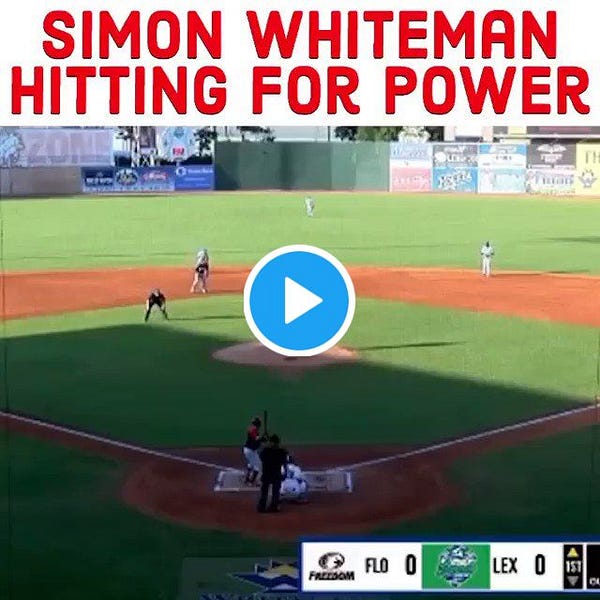
Even further down the 2019 draft, the Giants selected OF Najee Gaskins in the 20th round out of St. Cloud University and he, too, had a surprisingly productive debut. Though he was admittedly old for the AZL at 21, the small college vet hit a strong .340 in his debut, striking out just 14% of the time while walking 15% of the time. Yes! Gaskins is one of the answers to the trivia question at the top, walking 20 times and striking out just 19 in 134 PA. Does he have the foundational skills that the Giants can unlock to greater ability?
Then there are those, like Dubon, whose control of the zone is centered around an elite ability to make contact. The most prominent of those in 2019 was streaking star Luis Matos. Against the admittedly rudimentary level of pitching in the DSL, Matos showed a Joe Panik-esque ability to make contact, striking out just 11% of the time in his debut. His walk rates, like Dubon, lagged a little lower than the Giants probably wanted to see, but that ability to make hard contact with most of his swings was what really propelled his incredible year. Probably the best contact artist in the system is the young Nicaraguan OF Ismael Munguia. In more than 400 PA in Augusta in 2019, Munguia struck out less than 10% of the time, and that’s a mark he’s hit before in his career. Munguia’s career is a warning against paying too much attention to DSL stats, as he posted double-digit walk rates in his two DSL seasons but has shown much less patience in his three years in the states. Still, Munguia’s a high-motor guy who can play anywhere in the OF, uses his speed on both offense and defense, and makes a ton of contact. Lastly, Munguia’s Augusta teammate Diego Rincones is another player who belongs in the upper strata of contact artists in the Giants’ system. I wrote at length about Rincones recently. He needs to firm up his selectivity at the plate and use that discipline to hone in on pitches he can hit for more power, but his ability to make consistent contact is clearly present and his approach at the plate has been developing and advancing.
Let Loose the Hounds!
So those are some the names I’m keeping my eyes on as players who the Giants should be able to develop given their belief in the fundamental importance of strikezone control. But what about the opposite group — the Armani Smiths of the system? It’s worth noting, first of all, that the Giants’ preference for the above group can be seen in the actions they’ve taken to remake the talent pipeline. If we look at players with the worst K/BB ratios in the system in 2019, we’ll see that a lot of them are no longer in the system. This is certainly part of the reason that players like Aramis Garcia (114 K/34 BB), Chris Shaw (111/39), and Mike Gerber (140/39), have been sent to other organizations and why prospects like Manuel Geraldo (136/28), Gio Brusa (136/48), and Brandon Van Horn (114/19) have been let go. But there are still several in the system who intrigue with their raw power but whose extremely asymmetrical BB/K ratios raise concerns that they’ll be able to get to that power against good pitching.
Armani Smith, himself, has some of the best pure raw power in the system. He posted an eye-popping ISO over .300 in his Junior year at UC Santa Barbara. But all that power comes with a big amount of swing and miss. In his debut with Salem-Keizer, he produced 4 HRs in 43 games and hit .307 while striking out in more than 30% of his PA. An even more extreme version of that dichotomy came from Smith’s OF mate Alexander Canario, who struck out in nearly 1/3 of his PA in the NWL while also finishing 2nd in the league in HRs (part of his amazing 16 HRs in just 59 games in 2019). Joey Bart’s swing and miss issues weren’t nearly so pronounced as Canario’s, but still, for an advanced D1 college player, the fact that he produced 20% K rates to 5-6% BB rates at the low levels of NWL and Cal leagues does raise the odd eyebrow and could give us some insight into why the Giants’ front office maintained that Bart wasn’t yet prepared for a big league callup last summer.
Another member of the incredible 2018 J2 class, Rayner Santana really opened eyes in the DSL, hitting 10 HR and Slugging .553 in his debut while playing nearly the entire year as a 16-year-old. But, while the big, young catcher walked a ton as well (17%), his 27% K rate is probably the more significant number to keep an eye on. That’s a little too much swing and miss to feel fully comfortable with at that level (where Canario, for instance, struck out less than 15% of the time).
For the deep, deep cuts, you might want to keep an eye on LF Kwan Adkins. Adkins was a wide receiver on the Northeastern State (LA) football team, which might have held his development on the baseball team down. He hit under .200 for the first three years of his college career before blossoming with an .801 OPS his senior year, though even then he struck out 23% of the time against small college competition. But he’s shown all-fields power on the back fields in Scottsdale and in his NWL debut (.413 SLG). He’s still a very raw player, but with intriguing power and athleticism. Another deep sleeper candidate is David Villar. The 11th round pick in 2018 out of the University of South Florida has shown consistent power as a pro, posting a career ISO of about .200. But it’s come with a large wave of Ks as well — 144 in San Jose in 2019. Like Garcia, Shaw, and others, he feels out of step with the current Giants priorities, but perhaps with their help he can begin to curb his swing and miss excesses. Villar can take a walk (he walked 8.5% of the time in San Jose), but those huge strikeout totals do suggest issues with either a grooved swing or some big areas in the strike zone that he has trouble covering.
This is likely the case of all of the players in this group and the development challenge for the Giants — can they help the players with their plate coverage and get them to the point where they can damage enough different types of pitches to put competitive at bats together against top pitching? Though the Giants hitting development mantra these days is “crush it or let it go,” that only works if the ratio of what you can crush to what you can’t doesn’t leave enough of the strike zone up for grabs that higher level pitching can carve a hitter up consistently by pitching to the scouting report.
Which brings us to maybe the most interesting guy in the entire system — Hunter Bishop. For many of the players I’ve discussed today, the challenges are pretty straightforward: can they help Logan Wyatt or Luis Toribio create more loft or launch angle in their swings while maintaining their patient approach? can they help Armani Smith or Alex Canario gain control over the strikezone enough to maximize their game power?
Bishop, though, is a hybrid of the two categories — he’s probably the only prospect in the system who belongs in both of them. He comes to the Giants with huge power, extreme strike zone awareness, and an approach so disciplined that it almost verges on passivity. Bishop walked 24% of the time in the NWL (though he is not one of the answers to our trivia question, as he ended up with one more strikeout than walk 39/38). He knows what he can crush and he really crushes those balls. And he’s advanced enough to be disciplined about taking pitches he can’t crush. But there’s enough of the zone that he has trouble defending that pitchers can really attack him on the inner half, leading to some big strike out totals of his own. The challenge in developing Bishop will likely be making enough mechanical changes in his ability to cover the plate that he’s not giving pitchers an easy book to retire him. The Giants are likely excited about Bishop’s extreme discipline and want to help him enlarge his “destruction zone” just enough that his tremendous power will play in games. That might mean he needs to bring those eye-popping walk totals down a bit — nobody is going to walk 20% of the time against big league pitching — and hopefully some of the strikeouts as well, while allowing his power to play up and maximize his impact.
Reports on Bishop’s Instrux camp were strong, with Haines calling him the camp’s best hitter. Hopefully he’ll build on that with a strong 2021 campaign and really start pushing his progress.
There’s another similar player at the top of the system in Jacob Heyward who displays some of the downside of this approach. Though Heyward certainly doesn’t have the pedigree and extreme athletic tools of Bishop, their offensive approaches do have some similarity. Heyward has been an honest-to-god “Three True Outcomes” player his entire pro career. An extraordinary 43% of all of Heyward’s professional plate appearances have ended in a strike out (399), a walk (214), or a HR (34). Unfortunately, the ratio of those occurrences has been weighted far too heavily on the strikeout side. His career. 241 average and .390 Slugging overcome even the solid .360 OBP, though that level of plate discipline surely does impress the Giants brass.
I have no real answer for today’s question. There’s no magic elixir with this stuff and ultimately it’s the players themselves who have to take whatever information is available, absorb it into their body, and translate it into on the field success against pitchers throwing upper 90s with insane movement on the black. It’s a ridiculously hard game and whatever success players have is a reflection of their talent and diligence and work ethic.
It feels like the Giants believe that the first group, those who can control the strike zone consistently, has a leg up at developing their overall offensive game, and so that group maybe SHOULD see the best results going forward in the organization. Even so, the Giants are also pretty clearly attracted to the pure power potential that the second group can bring to impact a game as well.
Absent any clear answers, this is how I’m going to be watching the year to come for these players and more in the system. I want to see which of these groups seem to be having more success and, specifically, which of these players are able to build on their strengths while showing improvement in the flaws that might hold their development down. Will Wyatt get to more power while keeping the BB/K down? Will Canario and Smith keep the power up while balancing out their BB/K? Will a dark horse like Gaskins be able to build on the foundation of his BB/K to keep producing numbers at higher levels? These are some of storylines of 2021 that I’ll be watching.
As for the Trivia Answer, I didn’t expect many of you to come up with:
Mauricio Dubon (10 BB/9 K), PCL
Jose Hernandez (17 BB/16 K), DSL
Najee Gaskins (20 BB/19 K), AZL
Tyler Wyatt (38 BB/37 K), AZL

